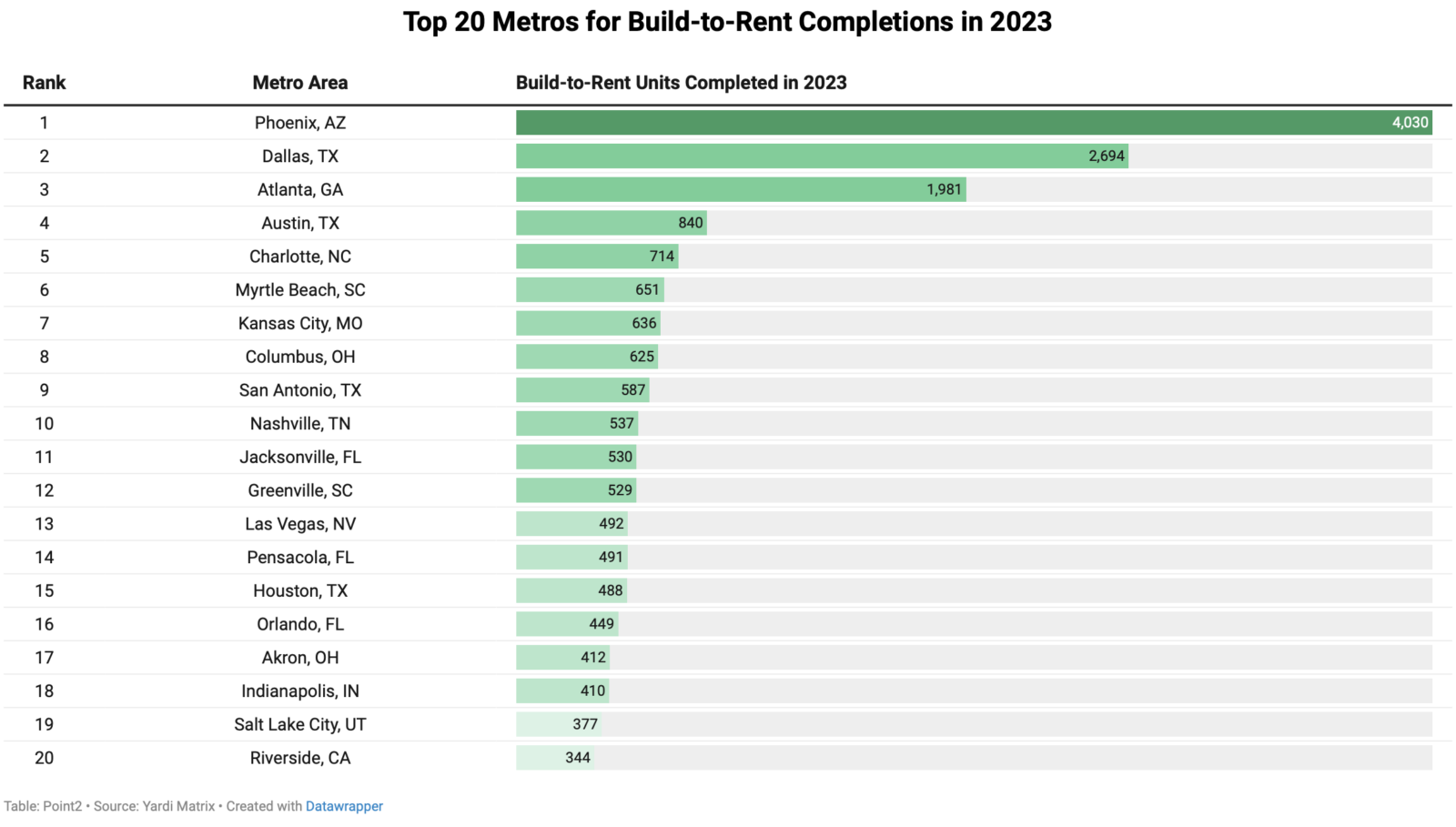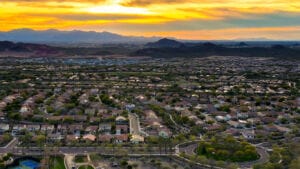What makes a suburb one of the best suburbs for house renters in Arizona? The suburbs where renters thrive are, of course, the ones where renter incomes are high or have been increasing, where there are plenty of spacious houses for rent to choose from and where the abundant job opportunities are attracting more and more people, injecting vitality into a growing community.
MORE NEWS: The 10 fastest-growing housing markets in Arizona
That’s exactly what’s going on in Phoenix and Tucson’s nearest suburban areas. Here, the suburbs and communities of single-family rentals make more sense than anywhere else. Encompassing nearly all of Arizona’s population, these sprawling metros continue to grow due to the area’s solid job market and relatively affordable housing, and especially due to these desert cities’ capacity to build and extend out rather than up, making it possible for single-family rental communities to flourish.
Here’s a quick peek at what our analysis revealed about the best suburbs for house renters in Phoenix and Tucson:
- Phoenix and Tucson split the top 10 almost evenly, with six suburbs from Phoenix and five from Tucson (El Mirage and Tanque Verde tied for third place).
- House renters thrive in Vail, Buckeye, El Mirage and Tanque Verde. These top suburbs boast the highest scores for metrics like renter income, house rental inventory, and living space, among others.
- A small town of 15,000 residents, Vail excels in areas like renter income, five-year income increase, number of houses for rent and average rental home size.
- Hot on its heels, Buckeye stands out as the fastest-growing suburb not just in Phoenix, but also in the entire state: It attracted more new residents than any other city in the U.S. in 2017, 2018 and 2021.
- El Mirage and Tanque Verde snatch the third spot thanks to their spacious rentals, high renter incomes and high shares of single-family renters, making for more cohesive communities.
The Suburbs Are Back With a Bang
Phoenix and Tucson’s single-family rental communities are the answer to the new American Dream
Researchers at the Harvard Joint Center for Housing Studies are reporting on the increasing popularity of suburban living among Millennials. It seems that, “after leading the back-to-the-city movement,” Millennials are now eager to start a new chapter in their life, one in which they get to have children, start a family and access the advantages of walkable communities farther away from city centers.
Not only that, but the pandemic pushed more than just Millennials toward the more spacious and open suburban life. And, in the aftermath of the pandemic, home prices exploded, which paved the way for Americans to consider the possibility that renting the American Dream — instead of buying it — could be more worthwhile.
This is what jumpstarted the build-to-rent housing sector and led to the return of the suburb. And, just like the communities of single-family rentals, they have been expanding and growing at a breakneck pace. In fact, increasing demand shows that the number of single-family home renters is surging, fueled by what seems to be the perfect storm on the housing market: Millennials are reaching their prime nesting years and are looking to accommodate their growing space needs, but the shortage of affordable homes makes young couples and families zone in on houses for rent rather than houses for sale.
One of the fastest growing states in the country, Arizona recorded a 44% population increase between 2000 and 2023, according to Census Bureau figures. What’s more, metro Phoenix is the most populous metropolitan area in the Southwest and the 10th largest in the country. The most recent Census estimates show that the metro recently surpassed 5 million residents for its total population.
As the City of Phoenix is home to just 1.7 million people, it’s obvious that the surrounding suburbs, exurbs and secondary cities are shouldering much of the growth, becoming home to the millions of new residents drawn to the area. And the same can be said about Arizona’s second largest city: The newly added houses for rent in Tucson and its suburbs show that house rental communities in the suburbs are taking off.
Top House Renters’ Havens: Vail, Buckeye, El Mirage & Tanque Verde
Tempe stands out as the only renter-majority suburb
If a suburb should truly adopt the symbol of the phoenix rising, that would be Tucson’s Vail. After the cattle and mining activities in the area slowly withered, the population dwindled to fewer than 10 people and the local school was all but closed. However, the addition of IBM to Southeast Tucson in 1980 kicked off a period of unprecedented growth for the whole area. According to the Greater Vail Chamber of Commerce: “By 1990, student enrollment in VSD had reached 1,000 students and growth really took off from there. The IBM facility was transformed into the top-ranked University of Arizona Science and Technology Park. Anchored by Raytheon and IBM, the Park became a vibrant employment center of over 6,000 people. The size of the Park is expected to double in the next five to 10 years. The Park, Davis-Monthan Airbase, and other employment centers, combined with the attraction of Arizona sunshine, resulted in a major housing boom in Vail.”
And it doesn’t seem like the growth spurt is slowing: At more than $125,000, Vail has the largest renter household income of all suburbs in the analysis, in addition to posting the second largest five-year increase (nearly 115%). Add to that the fact that Vail also boasts the third-largest inventory of available houses for rent relative to its population and it’s easy to understand why this particular suburb rules them all.
Buckeye is right behind Vail, with an almost equally impressive final score. Arizona's largest suburb by area saw its population increase more than 53% in the last five years. Not only that, but Buckeye was the fastest-growing city in the country in 2017, 2018 and 2021.
While Buckeye may be the fastest-growing suburb, that's far from the whole story. With so much land at its disposal, the suburb still has one of the lowest population densities of all the suburbs in the analysis. That means renters who join the community would really have room to breathe — and to grow. Houses for rent here are already generous in size, with an average of 5.5 rooms per household, but single-family rentals can get even more spacious.
The final score reveals the fastest-growing suburbs and the communities that would favor house renters the most. However, factors like cost of living, unemployment rate, share of renters and even commute time could help anyone wanting to move to an area to get a better picture of life in that suburb.

Phoenix Leads Build-to-Rent Housing Trend
Renting a single-family home is the mortgage-free, hassle-free way of life
As homeownership is increasingly tied up with a growing number of challenges, many house hunters are starting to focus on the mortgage-free, hassle-free renter lifestyle.
More specifically, the growing market for single-family rentals shows that renters are giving up on worrying about the down payment, mortgage rates and high home prices. Instead, they're starting to take advantage of the abundant indoor and outdoor space and home features that houses for rent have to offer.
According to Yardi Matrix data, a total of 27,500 homes for rent were completed in 2023 — and things are just getting started: Around 45,400 build-to-rent houses are currently under construction with developers in a hurry to meet increasing demand.
What's even more surprising is that, of the historically high 27,500 new houses for rent, more than half are in the top 20 largest U.S. metros.
And Phoenix blows all other metros out of the water: The 4,000+ houses for rent that came online in 2023 put the Arizona metro in a league of its own. This number represents a 10-year high and an impressive 164% growth compared to 2022.





